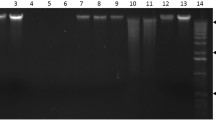Abstract
Sequencing of a high number of fungal genomes has become possible due to the development of next generation sequencing techniques (NGS). The most recent developments aim to sequence single-molecule long-reads in order to improve genome assemblies, but consequently needs higher quality (minimum >20 kbp) DNA as starting material. However, environmental-derived samples from soil, wood, or litter often contain phenolic compounds, pigments, and other molecules that can be inhibitors for reactions during sequencing library construction. In this chapter, we propose an optimized protocol allowing the preparation of high quality and long fragment DNA from different samples (mycelium, fruiting body, soil) compatible with the current sequencing requirements.
Access this chapter
Tax calculation will be finalised at checkout
Purchases are for personal use only
Similar content being viewed by others
References
Kirk PM, Cannon PF, Minter DW, Stalpers J (2008) Dictionary of the fungi. CABI, Wallingford
Goffeau A, Barrell BG, Bussey H, Davis RW, Dujon B, Feldmann H, Galibert F, Hoheisel JD, Jacq C, Johnston M, Louis EJ, Mewes HW, Murakami Y, Philippsen P, Tettelin H, Oliver SG (1996) Life with 6000 genes. Science 274:546
Galagan JE, Calvo SE, Borkovich KA, Selker EU, Read ND, Jaffe D, FitzHugh W, Ma LJ, Smirnov S, Purcell S, Rehman B, Elkins T, Engels R, Wang S, Nielsen CB, Butler J, Endrizzi M, Qui D, Ianakiev P, Bell-Pedersen D, Nelson MA, Werner-Washburne M, Selitrennikoff CP, Kinsey JA, Braun EL, Zelter A, Schulte U, Kothe GO, Jedd G, Mewes W, Staben C, Marcotte E, Greenberg D, Roy A, Foley K, Naylor J, Stange-Thomann N, Barrett R, Gnerre S, Kamal M, Kamvysselis M, Mauceli E, Bielke C, Rudd S, Frishman D, Krystofova S, Rasmussen C, Metzenberg RL, Perkins DD, Kroken S, Cogoni C, Macino G, Catcheside D, Li W, Pratt RJ, Osmani SA, DeSouza CP, Glass L, Orbach MJ, Berglund JA, Voelker R, Yarden O, Plamann M, Seiler S, Dunlap J, Radford A, Aramayo R, Natvig DO, Alex LA, Mannhaupt G, Ebbole DJ, Freitag M, Paulsen I, Sachs MS, Lander ES, Nusbaum C, Birren B (2003) The genome sequence of the filamentous fungus Neurospora crassa. Nature 422:857–868
Martinez D, Larrondo LF, Putnam N, Gelpke MD, Huang K, Chapman J, Helfenbein KG, Ramaiya P, Detter JC, Larimer F, Coutinho PM, Henrissat B, Berka R, Cullen D, Rokhsar D (2004) Genome sequence of the lignocellulose degrading fungus Phanerochaete chrysosporium strain RP78. Nat Biotechnol 22:695–700
Goodwin S, McPherson JD, McCombie WR (2016) Coming of age: ten years of next-generation sequencing technologies. Nat Rev Genet 17(6):333–351
Sanger F, Nicklen S, Coulson AR (1977) DNA sequencing with chain-terminating inhibitors. Proc Natl Acad Sci U S A 74(12):5463–5467
Grigoriev IV, Nikitin R, Haridas S, Kuo A, Ohm R, Otillar R, Riley R, Salamov A, Zhao X, Korzeniewski F, Smirnova T, Nordberg H, Dubchak I, Shabalov I (2014) MycoCosm portal: gearing up for 1000 fungal genomes. Nucleic Acids Res 42(1):D699–D704
Laiho O (1970) Paxillus involutus as a mycorrhizal symbiont of forest trees. Acta Forestalia Fennica 106:1–73
Yamad A, Katsuya K (1995) Mycorrhizal association of isolates from sporocarps and ectomycorrizal with Pinus densiflora seedings. Mycroscience 36:315–323
Fulton PJ, Chungwongse J, Tanksley SS (1995) Microprep protocol for extraction of DNA from tomato and other herbaceous plants. Plant Mol Biol Report 13:207–209
Manter DK, Vivanco JM (2007) Use of the ITS primers, ITS1F and ITS4, to characterize fungal abundance and diversity in mixed-template samples by qPCR and length heterogeneity analysis. J Microbiol Methods 71:7–14
Cébron A, Norini MP, Beguiristain T, Leyval C (2008) Real-time PCR quantification of PAH-ring hydroxylating dioxygenase (PAH-RHDα) genes from Gram positive and Gram negative bacteria in soil and sediment samples. J Microbiol Methods 73:148–159
Chemidlin Prévost-Bouré N, Christen R, Dequiedt S, Mougel C, Lelièvre M, Jolivet C, Shahbazkia HR, Guillou L, Arrouays D, Ranjard L (2011) Validation and application of a PCR primer set to quantify fungal communities in the soil environment by real-time quantitative PCR. PLoS One 6(9):e24166
Acknowledgments
Our research was financed by the “Institut National de la Recherche Agronomique” (INRA), the Région Grand Est and the lab of excellence ARBRE (ANR-11-LABX-0002-01). The protocols were developed at the INRA Grand Est-Nancy Ecogenomics facilities. Part of our research was sponsored by the Genomic Science Program of the US Department of Energy, Office of Science, Biological and Environmental Research (under contract DE-AC05-00OR22725) and the US Department of Energy (DOE) Joint Genome Institute (JGI; Office of Science of the US Department of Energy). We would like to thank Francis Martin for helpful discussions and input on this chapter.
Author information
Authors and Affiliations
Corresponding author
Editor information
Editors and Affiliations
Rights and permissions
Copyright information
© 2018 Springer Science+Business Media, LLC, part of Springer Nature
About this protocol
Cite this protocol
Fauchery, L., Uroz, S., Buée, M., Kohler, A. (2018). Purification of Fungal High Molecular Weight Genomic DNA from Environmental Samples. In: de Vries, R., Tsang, A., Grigoriev, I. (eds) Fungal Genomics. Methods in Molecular Biology, vol 1775. Humana Press, New York, NY. https://doi.org/10.1007/978-1-4939-7804-5_3
Download citation
DOI: https://doi.org/10.1007/978-1-4939-7804-5_3
Published:
Publisher Name: Humana Press, New York, NY
Print ISBN: 978-1-4939-7803-8
Online ISBN: 978-1-4939-7804-5
eBook Packages: Springer Protocols




